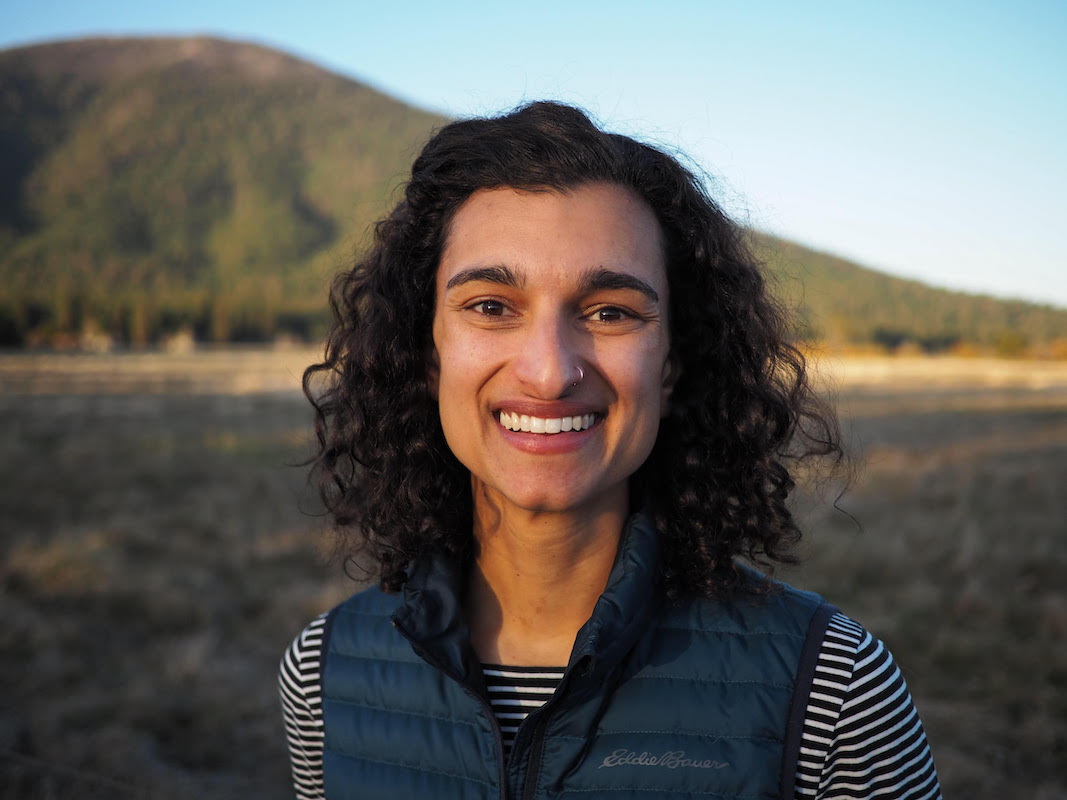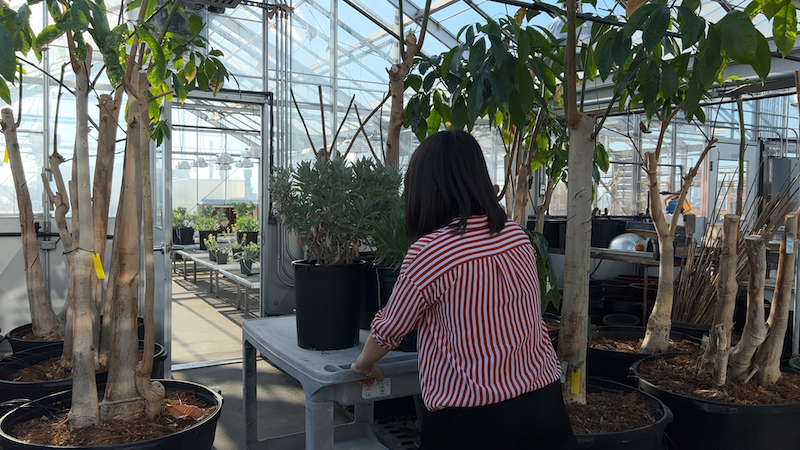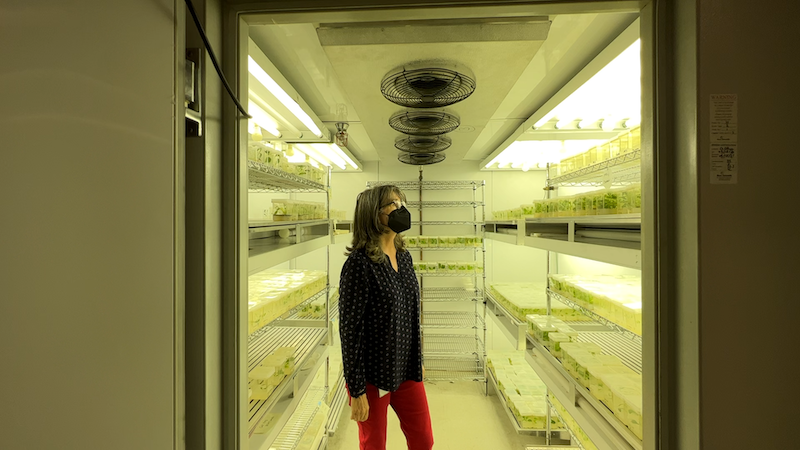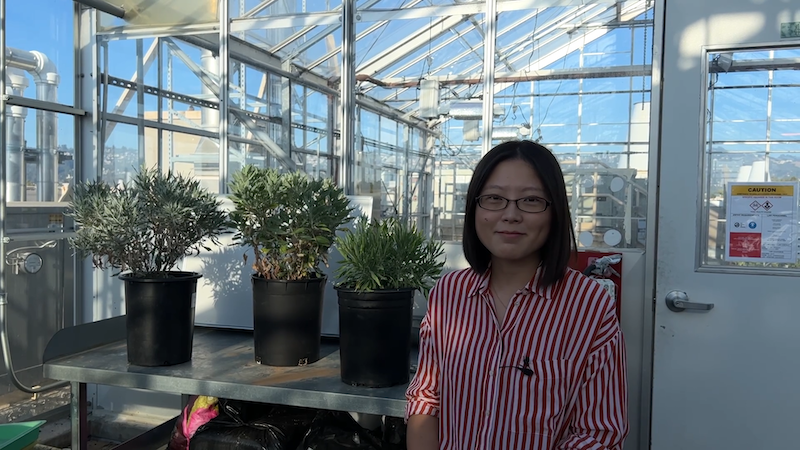
All you science podcast fans are in for a treat! We teamed up with another science podcast called Genome Insider for this full-length bonus episode. Genome Insider is a podcast from the Joint Genome Institute, a user facility of the US Department of Energy Office of Science located at Lawrence Berkeley National Lab in Berkeley, California.
The HudsonAlpha Genome Sequencing Center works with scientists at the JGI a lot. In fact, HudsonAlpha Faculty Investigator Jeremy Schmutz is the Plant Program Lead at the JGI. With all these collaborations, it was only fitting to bring our podcasts together to tell you about one of the projects HudsonAlpha and JGI have teamed up on.
Our transportation industry relies on rubber to succeed. In fact, about 70 percent of the global rubber industry is focused on automobile and plane tires. The remaining rubber is used for other goods like medical gloves, sporting gear, shoes, and clothing. It might be a surprise that nearly all the world’s natural rubber comes from one plant source grown almost exclusively in Asia. It’s great at producing latex that becomes rubber, but it’s vulnerable to disease and climate shifts.
Scientists are looking for other sources of natural rubber. One promising candidate is the Native American desert shrub, guayule. Join us for this bonus episode of Tiny Expeditions, “Growing a Shrubbier Version of Rubber,” as we learn how scientists are using genomic technology to help create another natural, reliable source of rubber.
Genome Insider is hosted by Menaka Wilhelm, a Communications & Outreach Specialist at JGI. To listen to more Genome Insider episodes, visit their website here or find them on your favorite podcast app.
To learn more about guayule and how genomics is poised to make it a viable natural rubber source, read this Everyday DNA article, Guayule: Can genetics create a natural US rubber source?


Behind the Scenes
Here are some photos from Menaka’s trip to the research greenhouse in Albany, California, just Northwest of Berkeley, where she talked with Colleen McMahan and Chen Dong.

Side by side, guayule shrubs (shown on the cart) and rubber trees (in black planter pots) look quite different, but both produce rubber. (Photo credit: Menaka Wilhelm)

Colleen McMahan takes a look at small guayule plants growing in tissue culture. This is how researchers grow plants that are genetically transformed. (Photo credit: Menaka Wilhelm)

Chen Dong with the three versions of Guayule that this project will study. (Photo credit: Menaka Wilhelm)
Menaka Wilhelm
Like many good ones, this story starts in a greenhouse.
Sarah Sharman
OK! So sunny, warm,
Menaka
Yeah – and this is a specific greenhouse. One I went to in Albany, California, just Northwest of Berkeley. It’s a rooftop greenhouse, where researchers grow plants for their work with the US Department of Agriculture
Sarah
Oh official!
Menaka
Exactly. And I want to point out one kind of tree growing in this greenhouse. It’s the rubber tree, a species called Hevea brasiliensis.
Sarah
So this is the tree where we get rubber for tires, rubber gloves, and also rubber boots.
Menaka
Exactly – and there are about a dozen rubber trees here in this greenhouse. They’re around six feet tall, with big, football-shaped leaves the size of your hand. And up and down their slim, tan trunks, are diagonal slashes.
Sarah
And that pattern? It’s not part of their bark.
Menaka
Growers cut those slashes – this is the first step in making rubber. It’s called tapping a rubber tree – a little like tapping a maple tree for sap, to make maple syrup. When you tap a rubber tree, liquid latex drains out of the bark.
Sarah
So, you collect that liquid, then process it into rubber. So, the trees are in the greenhouse for studies,
Menaka
Yeah, but the rubber trees aren’t our main event. They’re here for comparative experiments with the plant that’s really the star of the show because it makes rubber too.
Sarah
A spotlight-stealing shrub — Parthenium argentatum.
Menaka
Yeah. This shrub’s common name is guayule. It’s a more sustainable, climate-resilient plant, and researchers are betting that one day, this shrub could give the rubber tree a bit of a run for its money. So next door to those rubber trees? This greenhouse has another room. It’s full of these guayule shrubs.
<THEME>
Sarah
This is a special episode of Tiny Expeditions from the HudsonAlpha Institute for Biotechnology,
Menaka
And Genome Insider, from the Joint Genome Institute.
Sarah
I’m Dr. Sarah Sharman,
Menaka
And I’m Menaka Wilhelm. The JGI and HudsonAlpha work together on lots of projects,
Sarah
Including this one! So we’ve teamed up for this episode.
Menaka
It’s the story of the researchers who are working to make a shrubbier version of rubber.
Sarah
Because that shrub just might grow better in our warming world.
Menaka
And it could be a useful crop in multiple ways. Researchers are hoping to harvest rubber from its stems, then convert what’s leftover into other chemicals and fuels.
Sarah
So we’ll meet a few of the people behind that project. There’s a full team of researchers working with the JGI and HudsonAlpha on this.
Menaka
Yep. They’re from the Boyce Thompson Institute at Cornell University, Bridgestone, New Mexico State University, and the US Department of Agriculture. And they’re all very interested in this guayule shrub.
Sarah
So first — let’s start with why we need more sources of rubber.
Menaka
To be clear, there are two different kinds of rubber in our world.
Sarah
There’s synthetic rubber,
Menaka
Made from petroleum,
Sarah
And natural rubber,
Menaka
Which comes from plants.
Sarah
Synthetic rubber works well for lots of things. But for durability, natural rubber wins out. It’s stronger, and more resilient against wear. A lot of stuff in our world depends on it. I heard about this from Dave Dierig – he’s a plant geneticist working on this project at Bridgestone. As in, Bridgestone Tires.
Dave Dierig
So most tires, anything larger than a car tire, has a high percentage of natural rubber in it. Airplane tires are all natural rubber because synthetic rubber really can’t do the same things that natural rubber does.
Sarah
As one example, natural rubber stays flexible even at low temperatures. That’s why it’s key for airplane tires — they see a big temperature range. But there’s a pretty big problem with natural rubber.
Menaka
Almost all natural rubber comes from just one species of tree.
Sarah
Hevea brasiliensis, that species you saw in the USDA greenhouse.
Menaka
It’s a tree that provides a bunch of rubber — but it’s also a tree that’s in trouble.
Sarah
For starters? Rubber trees are all genetically identical. They’re like banana trees – they’re all clones.
Dave Dierig
So we’re concerned about all the risks that natural rubber plantations have right now with diseases. You know, it’s a tree, it’s a clonal crop.
Sarah
On a rubber tree plantation, every single tree has the same defenses against disease. If a tough fungus comes through? It can wipe out an entire plot of trees at once.
Menaka
And that’s happened.
Sarah
Yeah – rubber trees are native to Brazil. But they really don’t grow there anymore. A disease called South American leaf blight has pretty much squashed commercial rubber production in South America. So now, most commercial rubber grows in Southeast Asia. There, it’s safe from disease, for now. But it’s not safe from other issues.
Dave Dierig
Climate change is another issue that we’re worried about,
Sarah
Climate change is making both droughts and floods more extreme.
Menaka
Both are bad news for rubber trees.
Sarah
And Dave pointed out one more risk.
Dave Dierig
Labor shortages, because you have to go around to each tree on a daily basis and tap the tree to get the rubber out. So, it’s very, very labor intensive,
Menaka
So, yeah – the rubber trees are in a bit of a pickle.
Sarah
But natural rubber is hugely important for lots of industries. So Dave is looking elsewhere.
Dave Dierig
Every tire company is looking for some kind of alternate source or supplemental source of natural rubber.
Menaka
And actually, we’ve made rubber – at scale — from other plants before.
Sarah
Because lots of plants make rubber, actually.
Menaka
There’s some rubber in sunflower leaves and lettuce. And of course – there’s a shrub that makes a lot of rubber, that’s also high quality.
Sarah
Enter, guayule.
Menaka
That’s G-U-A-Y-U-L-E
Sarah
And pronounced why-yule-ee.
Menaka
The shrub that makes rubber!
Sarah
If we’re being honest, when you see guayule, it looks a bit forgettable.
Menaka
Truly, it’s a very shrubby desert plant. A lot of people describe it as tumbleweed-y. It grows about a foot or so off the ground, with little sage-green leaves.
Andrew Nelson
It’s not particularly showy, even the flowers don’t really look like much,
Menaka
Andrew Nelson is a plant biologist at the Boyce Thompson Institute at Cornell University. He’s leading this project. For Andrew, guayule’s humble appearance is not a problem.
Andrew Nelson
What’s interesting about guayule is that it produces an insane amount of rubber. It stocks up a lot of rubber, in its stems.
Menaka
The stems can have six or eight percent rubber. Not bad for a dusty desert shrub!
Sarah
And guayule has a bunch of advantages that could make it cost-effective and more sustainable in the long run.
Menaka
Unlike the rubber tree, there are different lines of guayule. So it has more potential for genetic diversity, which means more defense against disease.
Sarah
It’s native to a hot, desert area — Northern Mexico to the southwestern US. That means more resilience against climate change,
Menaka
Plus — guayule grows with less water than many row crops like alfalfa or corn.
Sarah
A more sustainable crop for farmers in desert areas.
Menaka
And harvesting guayule isn’t labor intensive the way tapping rubber trees is – you can cut stalks and stems from a bunch of shrubs at once, with help from machines.
Sarah
So, it’s a shrub that solves a lot of the rubber tree’s problems.
Andrew Nelson
In addition, when the rubber has been extracted from these plants, you can actually use what’s left over as kind of a natural biofuel.
Menaka
So you could grow guayule, then process it into two renewable products – rubber, and also chemicals!
Sarah
Wow, the wonder-shrub guayule!
Menaka
Dreamy.
Sarah
And actually, people have used the guayule plant throughout history. I looked into that for a piece I wrote for HudsonAlpha’s blog, Everyday DNA.
Menaka
Linked in the show notes!
Sarah
So let’s start with the first time guayule shows up in western records. That’s in the 1500’s… when colonizers from Spain noticed Aztec people playing with rubber balls made from guayule!
Menaka
And guayule has actually been mass-produced before, too, right?
Sarah
Yeah – in the early 1900’s, it was. Industrialists like John D. Rockefeller created a firm to turn guayule into rubber. They harvested wild guayule from Mexico, and it kind of worked. We used a lot less rubber then — but by 1910, about half of all US rubber was from that wild guayule.
Menaka
Wild guayule is quite the tongue twister. At this point, it sounds like it’s catching on.
Sarah
But then, between Mexico’s revolutions and over-harvesting, that wild guayule? That all fizzled out.
Menaka
Ah.
Sarah
And there was actually another time where lots of people worked on making rubber from guayule – World War II. The US got cut off from sourcing rubber from Asia after Japan seized rubber plantations. So, congress funded something called the Emergency Rubber Project. During that project, researchers planted and grew over 32,000 acres of guayule.
Menaka
So the goal was to work out how to farm a domestic, natural source of rubber.
Sarah
Right. But the push for that project ended with the war. Once we could get natural rubber from Asia again, that’s what we did.
Menaka
So no one has really figured out how to grow guayule … so that it makes enough rubber … to be a large-scale profitable crop.
Sarah
No. But understanding this plant better could change that! If these researchers can figure out how guayule makes rubber, they could boost its rubber production. And still keep all those other strengths guayule brings to the table.
Menaka
So as with many projects at the JGI and HudsonAlpha, researchers are aiming for better understanding in the form of genomics! Here’s Andrew Nelson again.
Andrew Nelson
So with Bridgestone, David Dierig, at Bridgestone, Colleen McMahan at USDA and myself, we, we spearheaded this proposal for JGI to actually sequence the genomes of these plants.
Menaka
Historically, it’s been hard to sequence guayule. It’s got a really big genome.
Sarah
But HudsonAlpha and the JGI have the expertise!
Andrew Nelson
And if we want to figure out like, what is actually working to turn on the rubber biosynthesis pathway in these plants and, um, you know, figure out all the molecular components, you know, we, we really need a genome.
Menaka
And actually, they’re not just stopping at one genome.
Sarah
They’ll sequence and analyze multiple plants.
Menaka
Right. In just a bit, we’ll head back to the greenhouse where we first started out, the one that’s growing guayule alongside rubber trees. It’s Colleen McMahan — the third researcher Andrew Nelson just shouted out — who showed me around there. She showed me the plants that will get sequenced, and she’s got lots to say about what the guayule genome will let this team do.
<Genome Insider Trailer>
Menaka
To recap where we’ve been so far – right now, we rely on pretty much only one way to make natural rubber. The rubber tree, Hevea brasiliensis.
Sarah
But it’s also a tree that’s up against disease and climate change.
Menaka
So researchers are trying to find other rubber-producing plants. And the guayule shrub is a great candidate.
Sarah
It grows in a harsh, desert climate.
Menaka
It’s easier to harvest.
Sarah
And it’s got more genetic diversity than the rubber tree.
Menaka
Yeah – and I actually saw some of that diversity firsthand.
Sarah
So cool. Set the scene for us.
Menaka
Of course. So this is back at the USDA greenhouse that we started this episode with. It’s a pretty big, rooftop greenhouse at the USDA building in Albany, California. Plenty of sunlight comes in. Colleen McMahan is showing me around. She’s a research chemist at the USDA who is also part of this project. So we’re in the greenhouse, and she wheels out a cart with three different potted guayule plants.
Colleen McMahan
There are three different, guayule varieties in the initial phase of the project. And the three plants you see right here are those three plants.
Menaka
They’re all little potted shrubs, about the size of a basketball, but they look different by eye. One is a dustier green, more like a sage plant. Another is a much brighter green, think, like basil. And the third is somewhere right in between those two.
Sarah
And I’d bet their differences go beyond their color.
Menaka
Right. Here’s Colleen.
Colleen McMahan
They’re quite different genetically as well. And so the information that we get from those plants will be huge.
Menaka
Overall, they want to understand how to get guayule to make more rubber. But it’s also important to keep its other good qualities in tact. So the idea.. is to look at a handful of plants, and see the genetics behind a variety of strengths.
Sarah
OK, to get a better picture overall.
Menaka
Right. These plants each produce different amounts of rubber and have unique disease resistance.
Sarah
Nice.
Menaka
Those are the broad strokes. But I want to get just a little more specific about these plants, actually.
Sarah
Let’s do it.
Menaka
- So these plants are actually very different in specific ways — It turns out, the greenest plant I saw is quite different from the other two, the ones that were more sagey green.
Sarah
Ok. One that’s different, two that are more similar. following so far.
Menaka
Great. So let’s start with that greener plant. It’s a diploid plant – it’s got two sets of chromosomes, and it reproduces by crossing with other plants. Chen Dong is a researcher who works with Colleen, and she told me the reason they want to look at that plant, is
Chen Dong
So we can just have a pure genome of guayule,
Menaka
So just a clear, complete genome. This is like our basic version of guayule.
Sarah
And what about the other two plants?
Menaka
Yeah – this is where our picture gets even more technical. The ones that are dustier green, that are more similar in color — they reproduce asexually. They’re both tetraploid plants, which means they’ve got four copies of their chromosomes.
Sarah
So double the chromosomes of our first plant.
Menaka
Yes!
Chen Dong
And these are the ones that, Bridgestone uses for, breeding.
Menaka
Bridgestone is interested in diploid plants, too – but these two lines are specifically part of their breeding program. And each of these tetraploid plants are important to this study for their own reasons. The plant that’s the most sagey green — it’s the smallest, but it produces a bunch of rubber.
Sarah
Seems like a great plant to work with, in this quest to crank up rubber production.
Menaka
And the other tetraploid plant is interesting for a different reason. They’ve already figured out how to edit its genes.
Colleen McMahan
So we can genetically transform the plant. We’ve had success with doing that with a number of genes and in entire pathways in a couple of cases.
Sarah
So they’re already able to tweak this plant.
Menaka
Right – the question is just which tweaks to make, for example, to boost the pathway that produces rubber.
Sarah
And that’s where all of JGI and HudsonAlpha’s genomic information comes in.
Menaka
Exactly. Beyond just getting the sequence of guayule’s genome, JGI and HudsonAlpha will help this team work out which genes are there, how they’re turned on and off, and what they do.
Sarah
Lots of information about how guayule makes rubber.
Menaka
So Colleen and Chen will get even more information from editing this line of plants. They’ll be able to find important genes, then basically delete them with CRISPR gene editing, to see exactly how important they are.
Chen Dong
We want to confirm the functionality of these genes that we use CRISPR to narrow down these genes and see what is happening to these plants.
Sarah
So cool.
Menaka
Right! But Colleen did point out – even though these greenhouse studies will give them a ton of information, there’s actually still more to the story.
Colleen McMahan
So there’s a really important, genetics-by-environment component for guayule, and that’s one of the areas that we’re studying in this project is, what happens to the gene expression as the environment changes. And we’re really excited about having the opportunity to look at that.
Menaka
So guayule growing in a controlled greenhouse will do things differently than guayule growing outside, in a field.
Sarah
Which brings us to our last researcher of this episode. He’s with Bridgestone, growing guayule in the field.
Von Mark Cruz
So, I’m Mark Cruz. I’m a plant breeder at Bridgestone Americas, in Eloy, Arizona.
Sarah
Mark works with Bridgestone at its research farm in Arizona. It’s two hundred and eighty-one acres of these hardy guayule shrubs. Picture green shrubs, about a foot tall, filed in organized rows in the dirt.
Menaka
A whole club of shrubs!
Sarah
That farm grows guayule for lots of projects. For this project, Mark is growing the same three lines of plants as Colleen and Chen. So he’ll be able to compare these field samples with their greenhouse plants, and see what changes outdoors.
Von Mark Cruz
So knowing the gene expression patterns and how those correlate to rubber production will really help. So our goal is to determine those gene expressions at the different locations, and maybe in the future we can link it to protein expression levels too.
Sarah
Like Colleen and Chen, they’ll take a look at the genes that help guayule make rubber. Mark is also interested in making guayule a hardier crop – one that more farmers can grow in more places. So he’s also looking at the genes that make this shrub cold-tolerant.
Menaka
That sounds like it means even more testing.
Sarah
Exactly. Besides that farm in Eloy, they’re growing guayule in two other field spots for even more comparison. So all in all, Mark and his team are growing these strains in three places, outside
Von Mark Cruz
In Salinas, in Parlier California, and Eloy, Arizona. And we, so basically I’m responsible for the field trials, and then we send the tissues to Cornell and Boyce Thompson.
Sarah
So by Cornell, Mark means he sends his samples over to Andrew Nelson.
Menaka
Right – the plant biologist at the Boyce Thompson Institute, who told us a bit about guayule earlier in this episode.
Sarah
Yeah. Andrew’s lab will help analyze those samples. The JGI and HudsonAlpha will help too.
Menaka
Ah. We’ve come all the way full circle. Must be nearly time to end this episode.
Sarah
Yep, I think we’ve just about covered it. We’ve gone from trouble with the rubber tree to the guayule shrub that could help.
Menaka
And we’ve seen how this team will use greenhouse plants, field trials and a whole bunch of analysis to understand the genes that matter for growing guayule, and boosting its rubber content.
Sarah
To grow a reliable, sustainable version of rubber – that also supports biofuels.
Menaka
So Sarah, now that we’re pretty much done, I realize I’ve waited this entire episode to bring something else up.
Sarah
OK?
Menaka
In terms of naming. I know we talked guayule, but like, it’s a shrub, that can make rubber – so do you think…this version of rubber should be called… shrubber?
Sarah
Maybe? Seems like it’s past time to run the credits.
<THEME>
Sarah
Tiny Expeditions is a production of the HudsonAlpha Institute for Biotechnology, a non-profit research institution located in Huntsville, Alabama.
Menaka
Genome Insider is a production of the Joint Genome Institute, a user facility of the US Department of Energy Office of Science located at Lawrence Berkeley National Lab in Berkeley, California.
Sarah
This episode was written and produced by Menaka Wilhelm.
Menaka
Ashleigh Papp reported the interviews with researchers Dave Dierig, Mark Cruz, Chen Dong, and Colleen McMahan.
Sarah
AJ Bouchie reported the interview with Andrew Nelson.
Menaka
We had production help from Chris Powell, Massie Ballon, Allison Joy, Ingrid Ockert and Graham Rutherford.
If you liked this episode, help someone else find it! Tell them about it, send a link over, or leave us a review wherever you’re listening to the show.
Thanks for tuning in – until next time!
[wprpw_display_layout id=8]






